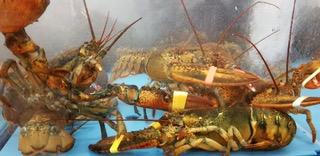
Research demonstrates that more than seven out of ten Brussels residents support a legal ban on the unstunned killing of lobsters
In a new campaign GAIA calls the three regional animal welfare ministers to ban the live cooking and cutting in half of lobsters. “We want lobsters, at the very least, to be stunned before killing so that they do not have to experience pain,” says GAIA chairman Michel Vandenbosch. “Stunning lobsters is perfectly possible with the Crustastun, an electrical stunning and killing device.” A study carried out by Ipsos[1] provides that more than seven out of ten Brussels inhabitants support the animal rights organisation’s demand for a ban on the unstunned killing of lobsters. “Scientific research indicates that crustaceans experience pain and social awareness is rapidly growing. The time is right to end the live cooking of lobsters and cutting them in half. These animals are not ‘just’ lobsters; they’re animals that really feel pain.”
In 2019, 3.9 million live lobsters were imported into Belgium. Therefore, it’s no surprise that Belgium is the world’s fifth largest consumer of lobster. Looking at the ratio per inhabitant, Belgians are the largest consumer of lobster in the world. 63% of Brussels inhabitants sometimes eat lobster, while 31% only eat them on special occasions. Ten percent of Brussels inhabitants who eat lobster effectively kill the lobster themselves during preparation. 85% percent of the inhabitants of Brussels who effectively kill the lobster themselves boil the lobster alive, while 15% cut the alive lobster in half. Both methods, as well as all others that kill the lobster without stunning, are unacceptable to GAIA. GAIA recommends that electrical stunning is applied. “Crustaceans can be stunned (within one second) and killed painlessly (within five seconds) using a sufficiently high electrical current,” says Vandenbosch.
From capture to plate: agony
The lobster’s journey from capture to death is agonizing. Live lobsters are transported from Canada to Belgium in polystyrene foam boxes with gel packs. The lobsters are held vertically with their claws up. “Even wine bottles have more space in a box,” says Vandenbosch. At best, lobsters are kept alive in water tanks on arrival, sometimes for months, with their claws tied together, subject to high stocking density, artificial bright lights, and with no shelter. Often, restaurants don’t even bother to provide a water tank and the animals are simply put on ice alive. Exposed to air, their condition weakens noticeably: once out of the water lobsters die after a few days. “The worst part of this inhumane agony is then still to come: the animals are then cooked or cut in half alive without stunning. A treatment that vertebrates would never be subjected to.”
Pain
Recent scientific research (by, among others, Professor Bob Elwood of Queen’s University Belfast) demonstrates that crustaceans, such as crabs and lobsters, do not only react with reflexes when exposed to harmful stimuli, but experience pain. A prominent group of brain scientists from various disciplines (neuroscience, neurophysiology, neuropharmacology, neuroanatomy, and computational neuroscience) signed the Cambridge Declaration on Consciousness[2]. The Declaration sets out that not only humans but also vertebrates and invertebrates have (a level of) consciousness, feeling, and pain perception.
Most inhabitants of Brussels are aware lobsters feel pain
An increasing portion of the population is also aware of this scientific reality: 83% percent of the inhabitants of Brussels are aware that lobsters feel pain. In fact, 4 out of 5 inhabitants of Brussels think that lobsters feel pain when they are cooked or cut in half while still alive. 18% percent of the inhabitants of Brussels that don’t eat lobsters decided to not eat them because they are treated poorly.
“We can no longer tolerate that yearly almost 4 million lobsters, imported into Belgium, are killed without being stunned and thus die in a cruel way. It is our ethical responsibility to prevent as much suffering as possible for the lobster. Especially when that suffering is (technically) avoidable. We therefore ask the three regional ministers for animal welfare to introduce a ban on the live cooking and cutting in half of lobsters, as has been done already in Switzerland.” Such a ban would have the support of the large majority of the population: 74% percent of the inhabitants of Brussels agree that a legal ban on the killing of lobsters without stunning must be imposed.
A more animal-friendly stunning and killing device: Crustastun
Crustastun is an electrical stunning and killing device to prepare lobster without the meat of the lobster losing any ‘juiciness’ or ‘suppleness’. It switches off the pain sensation within one second and can kill the lobste after five seconds. “The argument from chefs and amateur chefs that no other method that preserves the quality of the product (lobster) exists is utter nonsense.”
With its campaign, GAIA calls on everyone to sign the petition via www.gaia.be.
[1] Representative sample taken by research bureau Ipsos on behalf of GAIA between 6 March and 10 March 2020. All figures and percentages mentioned in this press release are taken from that survey.
[2] http://fcmconference.org/img/CambridgeDeclarationOnConsciousness.pdf
